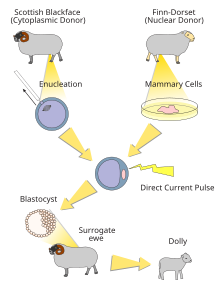
Back Kloning AF استنساخ Arabic ক্ল’নিং AS Clonación AST Klonlaşdırma AZ Клонлаштырыу BA Клониране Bulgarian ပွုံႏဗွိုန်မျိုꩻပွာꩻ BLK অনুকৃতি উৎপাদন (জীববিজ্ঞান) Bengali/Bangla Kloniranje BS

A clone is any cell or individual which is identical to another.
In biology, cloning is the process of producing one or more genetically identical individuals. With whole individuals, it usually means the deliberate production of an identical copy. This was first achieved in mammals with the famous Dolly the sheep. Human identical twins are natural clones. So are the offspring of asexual reproduction, and any parthenogenetic reproduction which does not involve meiosis.[1]
Cloning is natural to some animals, but rare in mammals. An exception is the nine-banded armadillo, which normally gives birth to identical quadruplets.
In genetics and cell biology, cloning refers especially to the DNA sequence, and by implication all the other macromolecules.
Clones in cell lines occur, but there are some obvious provisos. Changes to the DNA in any shape or form means the daughter cells are not identical with the mother cells. Typically during development genes are switched on and off, and the daughter cells gradually become differentiated into mature tissue cells. These are not identical with the original stem cells, so they are clones only in the sense of being derived from the same mother cell.
The laboratory copying of a molecule to produce exact copies is also called cloning.
- ↑ If there is crossing over between the paired chromosomes in the cells leading up to the egg, then the eggs will not be identical.